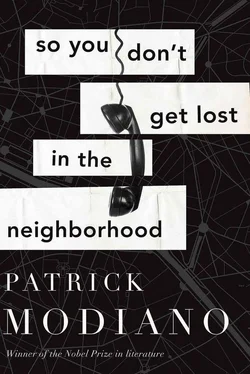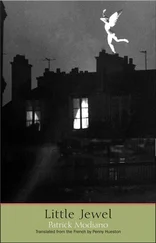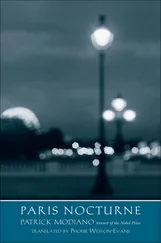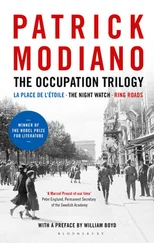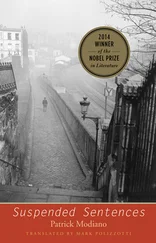When he returned to his study, she was stretched out on the sofa, clad in that strange black satin dress with two yellow swallows. He was confused for a moment. Was she wearing that dress when he had opened the door to her? No, she was not. Her shirt and black trousers were rolled up in a ball on the floor, next to her slip-on shoes. Her eyes were closed and she was breathing steadily. Was she pretending to be asleep?
She had left at about midday and Daragane was alone, as usual, in his study. She was worried that Gilles Ottolini might be back already. When he went to the casino in Charbonnières, he sometimes caught the train for Paris very early on the Monday morning. Through the window, he had watched her walk away wearing her shirt and her black trousers. She was not carrying the plastic bag. She had left it behind on the sofa along with the dress. It took Daragane a long time before he found the visiting card she had given him, a faded paper visiting card. But the mobile telephone number did not answer. She would surely ring him back in due course, as soon as she noticed that she had forgotten the dress.
He took it out of the bag and looked at the label again: “Silvy-Rosa. Fashion design. Rue Estelle. Marseille”. This reminded him of something, even though he had never been to Marseille. He had read this address before, or else heard the name. When he was younger, this type of apparently insignificant mystery could keep him busy for several days during which he searched stubbornly for a solution. Even if it were a matter of a tiny detail, he experienced a feeling of anxiety and privation for as long as he failed to make the connection, rather like a piece of a jigsaw puzzle that has been lost. Sometimes, it was a phrase or a line of verse for which he wanted to find the author, sometimes, a simple name. “Silvy-Rosa. Fashion design. Rue Estelle. Marseille”. He closed his eyes and tried to concentrate. Two words came to mind that seemed to be associated with this label: “La Chinoise”. It would require the patience of a deep-sea diver to discover the link between “Silvy-Rosa” and “La Chinoise”, but for several years he had no longer had the strength to devote himself to this type of exploit. No, he was too old, he preferred to float along calmly. . “La Chinoise”. . Was it on account of this Chantal Grippay’s black hair and slightly slanted eyes?
He sat down at his desk. That night, she had not noticed the scattered pages and the deletions in blue pencil. He opened the cardboard folder that he had left by the telephone and took out the book that was inside it. He started to leaf through Le Flâneur hippique . It was a recent reprint of a book whose copyright dated from before the war. How could Gilles Ottolini have the cheek, or the naivety, to claim to be its author? He closed the book and glanced at the sheets of paper in front of him. During his first reading, he had skipped sentences because the letters were too cramped together.
Once again, the words danced. There were clearly other details relating to Annie Astrand, but he felt too tired to take them in. He would do so later, in the afternoon, when he had had a rest. Or else he might decide to tear up the pages, one by one. Yes, he would see about that later.
Just as he was putting the “dossier” back in its cardboard folder, his eyes fell on the photograph of the child, which he had forgotten about. On the back of it, he read: “3 passport photos. Unidentified child. Search and arrest Astrand, Annie. Customs post Ventimiglia. Monday, 21 July 1952.” Yes, it was indeed the enlargement of a passport photograph, as he had thought yesterday afternoon in the room in rue de Charonne.
He could not keep his eyes off this photograph and he wondered why he had forgotten it among the sheets in the “dossier”. Was it something that embarrassed him, an exhibit, to use the legal language, and which he, Daragane, had wanted to erase from his memory? He experienced a sort of giddiness, a tingling sensation at the roots of his hair. This child, so detached from him over such a very long time to the extent that he had become a stranger, was, he was forced to acknowledge, himself.
DURING A DIFFERENT AUTUMN TO THAT SUNDAY at Le Tremblay, an autumn equally long ago, Daragane had received a letter at square du Graisivaudan. He was walking past the concierge’s door just as she was about to distribute the post.
“I suppose you’re Jean Daragane.” And she handed him a letter that had his name written in blue ink on the envelope. He had never received any post at this address. He did not recognise the handwriting, a very large handwriting that covered the entire envelope: Jean Daragane, 8 square du Graisivaudan, Paris. There was not enough space for the number of the arrondissement. On the back of the envelope, a name and an address: A. Astrand, 18 rue Alfred-Dehodencq, Paris.
For a few seconds, this name did not register with him at all. Was it because of the simple initial “A” that concealed the first name? Later on, he reckoned that he had had a premonition because he hesitated to open the letter. He walked to the boundary between Neuilly and Levallois, through that area where, in two or three years’ time, the garages and humble houses would be torn down to build the ring road. ASTRAND. How could he not have realised, in that very instant, whom it referred to?
He turned around and walked into the café beneath one of the blocks of flats. He sat down, took the letter out of his pocket, asked for an orange juice, and, if possible, a knife. He opened the letter with the knife, because he feared that if he used his hands he might tear the address on the back of the envelope. All it contained were three passport photos. In all three, he recognised himself as a child. He remembered the afternoon on which they had been taken, in a shop, the other side of the pont Saint-Michel, opposite the Palais de Justice. Since then, he had often walked past this shop, exactly as it was in the old days.
He needed to find these passport photos to compare them with the enlargement that was part of Ottolini’s “file”. In the suitcase in which he had crammed letters and papers that were at least forty years old and to which he had, fortunately, lost the key? No point. They were certainly the same photographs. “Unidentified child. Search and arrest Astrand, Annie. Customs post Ventimiglia. Monday 21 July 1952.” They must have arrested and searched her at the very moment she was preparing to cross the frontier.
She had read his novel, Le Noir de l’été and she had recognised an episode from that particular summer. Otherwise, why would she have written to him after fifteen years? But how could she have known his temporary address? Especially since he rarely slept at square du Graisivaudan. He spent the greater part of his time in a room in rue Coustou and in the place Blanche neighbourhood.
He had written this book only in the hope that she might get in touch with him. Writing a book, for him, was also a way of beaming a searchlight or sending out coded signals to certain people with whom he had lost touch. It was enough to scatter their names at random through the pages and wait until they finally produced news of themselves. But in the case of Annie Astrand, he had not mentioned her name and he had endeavoured to cover his tracks. She would not be able to recognise herself in any of his characters. He had never understood why anyone should want to put someone who had mattered to them into a novel. Once that person had drifted into a novel in much the same way as one might walk through a mirror, he escaped from you forever. He had never existed in real life. He had been reduced to nothingness. . You needed to go about it in a more subtle way. For example, in Le Noir de l’été , the only page in the book that might attract Annie Astrand’s attention was the scene in which the woman and the child walk into the shop with the instant-photo Photomaton booth, on the boulevard du Palais. He does not understand why she pushes him into the booth. She tells him to stare into the screen and not to move his head. She draws the black curtain. He is sitting on the stool. A flash blinds him and he closes his eyes. She draws the black curtain again, and he leaves the booth. They wait for the photos to fall from the slot. And he has to do it all over again because his eyes are shut in the photos. Afterwards, she had taken him to have a grenadine at the nearby café. That was what had happened. He had described the scene precisely and he knew that this passage did not fit with the rest of the novel. It was a fragment of reality that he had smuggled in, one of those private messages that people put in small ads in newspapers and that can only be deciphered by one person.
Читать дальше
